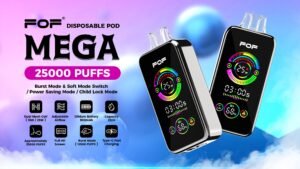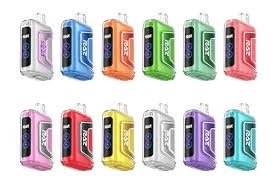Propylene glycol (PG) is a common ingredient in vape juice. But what if you're sensitive to it or prefer to avoid it? Where can you find PG-free options?
You can find vape juice that is free of propylene glycol (PG) primarily at specialized vape shops and online retailers. These PG-free e-liquids typically use vegetable glycerin (VG) as the sole base. Look for labels that explicitly state "100% VG" or "PG-free".
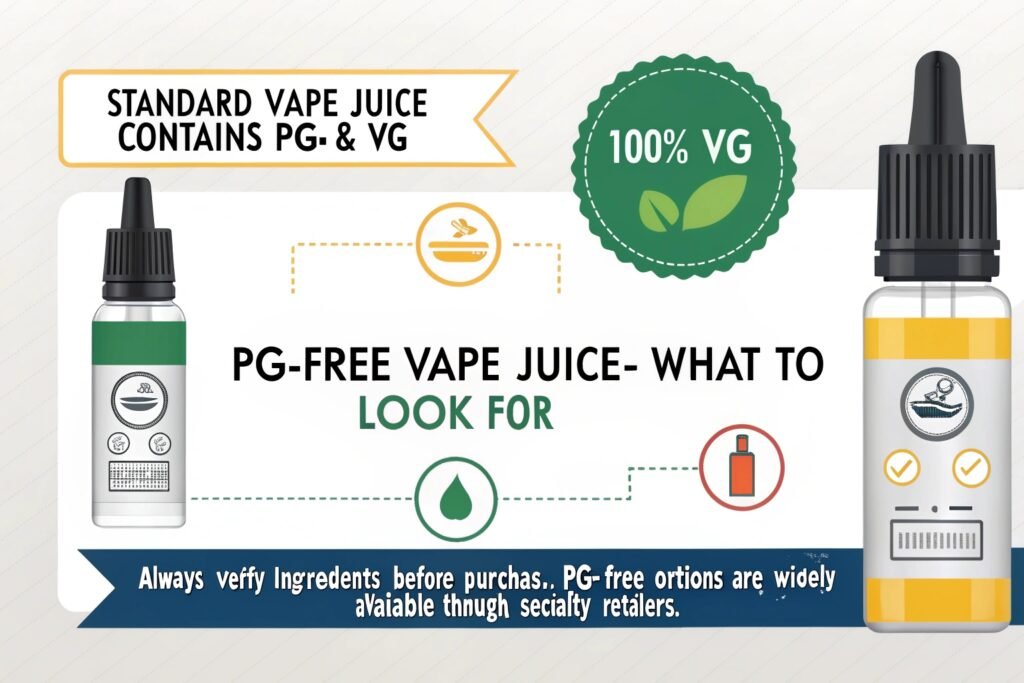 "A bottle of 100% VG vape juice with a clear label stating 'PG-Free'"
"A bottle of 100% VG vape juice with a clear label stating 'PG-Free'"
As someone who's been around the vape industry, I know it can be tricky to navigate the options. Let's explore where to find PG-free vape juice and what to consider.
Can you get vape juice without propylene glycol?
The good news is, yes, you can! PG is a common base, but it's not the only one.
Yes, it is possible to get vape juice without propylene glycol (PG). These e-liquids use vegetable glycerin (VG) as the primary base. They are often marketed to people with PG sensitivities or allergies.
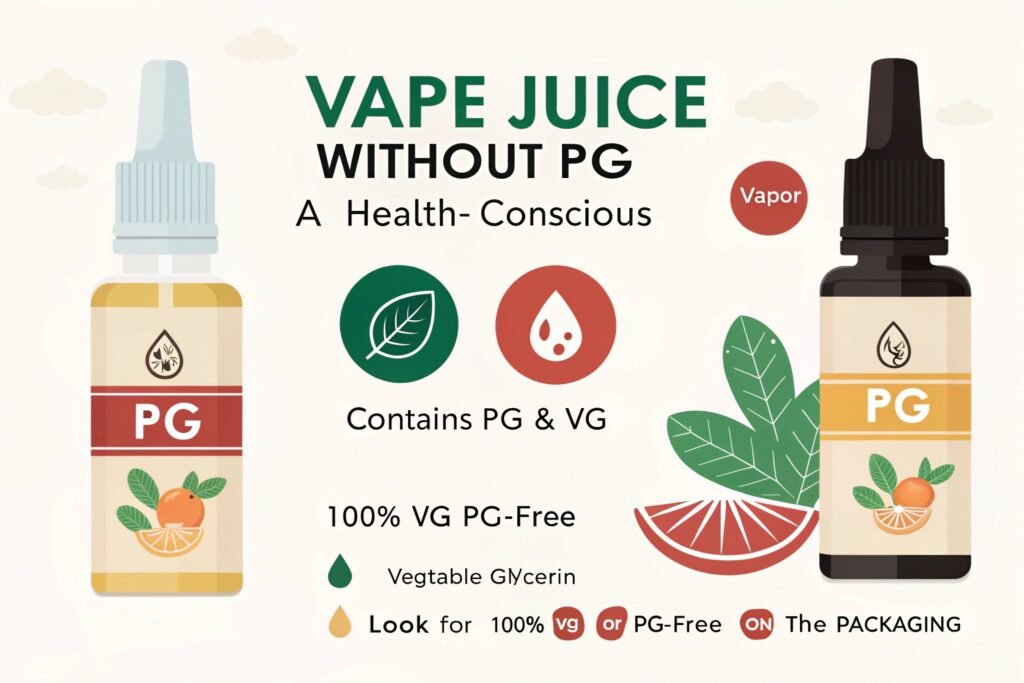 "A side-by-side comparison of PG and VG, highlighting their different properties"
"A side-by-side comparison of PG and VG, highlighting their different properties"
Finding PG-free vape juice1 requires a bit of searching, but it's definitely achievable.
The reasons why individuals may prefer PG-free vape juice are diverse, encompassing health considerations, personal preferences, and vaping experiences. Drawing from my understanding of chemical sensitivities and user feedback, I've identified the following key factors. The propylene glycol sensitivity or allergy can trigger adverse reactions – some individuals experience sensitivity or allergy to propylene glycol, leading to symptoms such as sore throat, dry mouth, skin irritation, or respiratory issues, prompting them to seek PG-free alternatives. The vegetable glycerin2 provides a smoother and milder vaping experience – vegetable glycerin (VG) offers a smoother and milder vaping experience compared to PG, producing thicker vapor clouds and reducing the harshness on the throat, making it a preferred choice for those seeking a gentler vape. The PG wicks faster than VG, but is not suitable for sub-ohm devices – PG wicks faster than VG, is not suitable for sub-ohm devices. The PG carries flavor better than VG and is more suitable for new vapers - PG carries flavor better than VG and is more suitable for new vapers. The personal preference for vapor production and throat hit influences the choice – some vapers prefer the thicker vapor clouds produced by VG-based e-liquids, while others prefer the stronger throat hit provided by PG-based e-liquids, leading them to choose PG-free options based on their individual preferences. The concerns about the safety of PG additives drives the search for alternatives – concerns about the safety of PG additives, such as diacetyl and acetyl propionyl, drive some vapers to seek PG-free alternatives with cleaner ingredient lists and fewer potential health risks. The specific vaping devices and coil types require certain e-liquid compositions – certain vaping devices and coil types perform better with VG-based e-liquids, particularly sub-ohm devices with larger coils, leading users to choose PG-free options to optimize their vaping experience.
The places to find PG-free vape juice include specialized vape shops, online retailers, and custom e-liquid mixing services. Through researching market trends and retailer offerings, I've identified the following key sources. The specialized vape shops often carry a wider selection of PG-free e-liquids – specialized vape shops often cater to specific needs and preferences, carrying a wider selection of PG-free e-liquids and providing knowledgeable staff who can offer personalized recommendations. The online retailers offer a convenient way to browse and purchase PG-free options – online retailers offer a convenient way to browse and purchase PG-free options from the comfort of home, with detailed product descriptions, customer reviews, and competitive pricing. The custom e-liquid mixing services allow users to create personalized PG-free blends – custom e-liquid mixing services allow users to create personalized PG-free blends with their preferred flavors and nicotine strengths, ensuring a tailored vaping experience. The health food stores and natural product retailers may carry PG-free e-liquids – some health food stores and natural product retailers may carry PG-free e-liquids with natural flavorings and organic ingredients, catering to health-conscious consumers. The direct-to-consumer brands offer exclusive PG-free formulations – direct-to-consumer brands often focus on specific formulations and cater to niche markets, offering exclusive PG-free options that are not available through traditional retail channels.
The factors to consider when choosing PG-free vape juice include the VG/PG ratio3, flavor options, and nicotine strength. Through analyzing product specifications and user reviews, I've identified the following key considerations. The VG/PG ratio affects vapor production and throat hit – the VG/PG ratio significantly affects vapor production and throat hit, with 100% VG e-liquids producing thicker vapor clouds and a smoother throat hit compared to e-liquids with a higher PG content. The flavor options cater to individual preferences – the flavor options available in PG-free e-liquids should cater to individual preferences, with a wide range of fruit, dessert, menthol, and tobacco flavors to choose from. The nicotine strength matches the user's needs – the nicotine strength should match the user's needs and vaping habits, with options ranging from nicotine-free to high-nicotine concentrations to satisfy different levels of nicotine dependence. The ingredient quality and sourcing ensure purity and safety – the ingredient quality and sourcing should be transparent, with reputable manufacturers using high-quality VG, flavorings, and nicotine to ensure purity and safety. The third-party testing and certifications validate the product's claims – third-party testing and certifications, such as ISO or GMP certifications, validate the product's claims and ensure that it meets industry standards for quality and safety.
Is there a vape that doesn't contain propylene glycol?
It's not the vape device itself, but rather the e-liquid you use with it.
No, the vape device itself doesn't contain propylene glycol. It's the e-liquid that you put inside the vape device that may or may not contain PG. You can use any vape device with PG-free e-liquid as long as it is compatible with the e-liquid's viscosity.
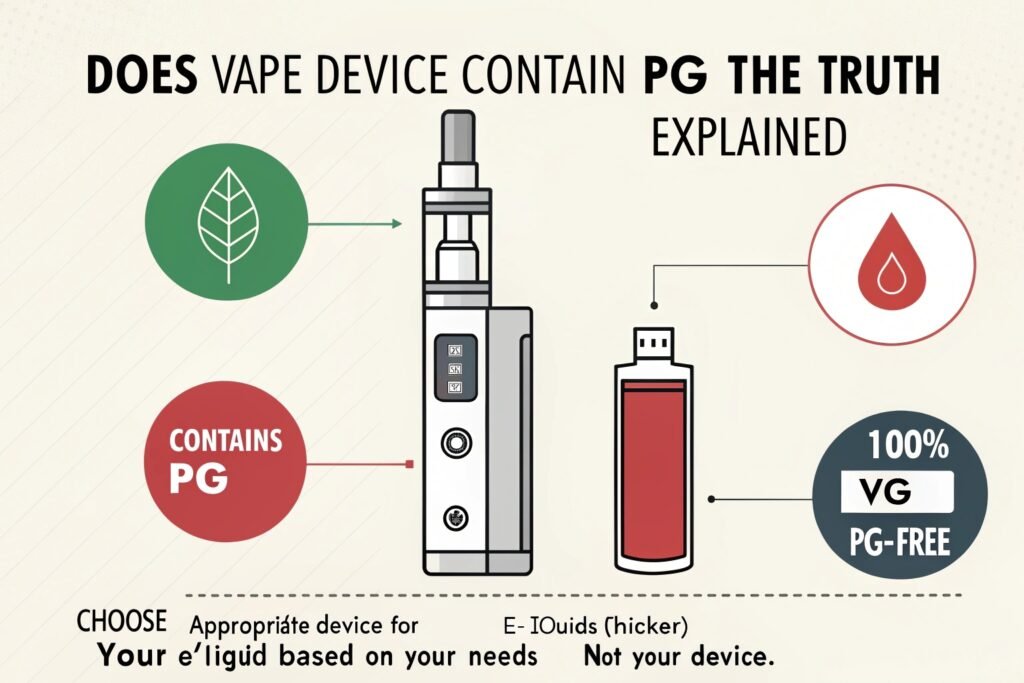 "A hand filling a vape device with e-liquid labeled 'PG-Free'"
"A hand filling a vape device with e-liquid labeled 'PG-Free'"
The key is to choose the right e-liquid for your device and your preferences.
The compatibility of vape devices with PG-free e-liquids depends on the device type, coil resistance, and wicking material. Drawing from my understanding of vaping technology and e-liquid properties, I've identified the following key considerations. The pod systems with low-wattage coils are generally compatible with high-VG e-liquids1 – pod systems with low-wattage coils are generally compatible with high-VG e-liquids, as they produce less heat and require less wicking efficiency. The sub-ohm tanks with high-wattage coils perform best with thicker VG-based e-liquids – sub-ohm tanks with high-wattage coils perform best with thicker VG-based e-liquids, as they produce more heat and require efficient wicking to prevent dry hits. The rebuildable atomizers (RBAs) offer the most flexibility in terms of e-liquid compatibility – rebuildable atomizers (RBAs) offer the most flexibility in terms of e-liquid compatibility, as users can customize the coil resistance and wicking material to suit their preferences. The devices with adjustable airflow allow users to fine-tune the vaping experience – devices with adjustable airflow allow users to fine-tune the vaping experience by controlling the amount of air that flows over the coil, optimizing vapor production and flavor. The devices with temperature control settings enable users to prevent overheating and dry hits – devices with temperature control settings enable users to prevent overheating and dry hits by limiting the maximum temperature of the coil, enhancing safety and preventing the combustion of e-liquid.
The potential issues with using high-VG e-liquids in certain devices include wicking problems2, dry hits, and reduced flavor intensity. Through analyzing user feedback and technical specifications, I've identified the following key challenges. The wicking problems can occur due to the higher viscosity of VG-based e-liquids – the higher viscosity of VG-based e-liquids can cause wicking problems, particularly in devices with small wicking holes or dense wicking materials, leading to dry hits and reduced vapor production. The dry hits can result from insufficient e-liquid reaching the coil – dry hits can result from insufficient e-liquid reaching the coil, leading to a burnt taste and potential damage to the coil. The reduced flavor intensity can be due to the lower flavor-carrying capacity of VG compared to PG – the lower flavor-carrying capacity of VG compared to PG can result in reduced flavor intensity, requiring users to use more concentrated flavorings to achieve the desired taste. The coil gunking can occur due to the caramelized sugars in VG-based e-liquids – the caramelized sugars in VG-based e-liquids can cause coil gunking, reducing the lifespan of the coil and affecting the flavor and vapor production. The leaking can result from the thinner consistency of some VG-based e-liquids – the thinner consistency of some VG-based e-liquids can result in leaking, particularly in devices with poor sealing or worn-out O-rings.
The tips for optimizing the vaping experience with PG-free e-liquids include using appropriate devices, adjusting settings, and priming coils3 properly. Through analyzing best practices and expert recommendations, I've identified the following key strategies. The using appropriate devices designed for high-VG e-liquids – using appropriate devices designed for high-VG e-liquids, such as sub-ohm tanks with large wicking holes or rebuildable atomizers with efficient wicking configurations, ensures optimal performance and prevents wicking problems. The adjusting the wattage and airflow settings to match the e-liquid viscosity – adjusting the wattage and airflow settings to match the e-liquid viscosity allows users to fine-tune the vaping experience and prevent dry hits or flooding. The priming coils properly by saturating the wicking material before use – priming coils properly by saturating the wicking material before use ensures that the coil is fully saturated with e-liquid, preventing dry hits and extending the lifespan of the coil. The using e-liquids with higher flavor concentrations to compensate for the lower flavor-carrying capacity of VG – using e-liquids with higher flavor concentrations compensates for the lower flavor-carrying capacity of VG, ensuring that the flavor intensity is satisfactory. The cleaning and maintaining the device regularly to prevent gunk buildup – cleaning and maintaining the device regularly prevents gunk buildup, ensuring optimal performance and prolonging the lifespan of the device.
What is the safest vape juice to use?
Safety is a top concern for vapers. What makes vape juice "safe"?
**The "safest" vape juice is subjective, but generally, it's one with the fewest additives and the highest quality ingredients. Look for e-liquids with:
- Clear ingredient lists
- Third-party testing
- No added chemicals like vitamin E acetate or diacetyl.
- Opt for simpler flavors, as complex ones often have more chemicals.**
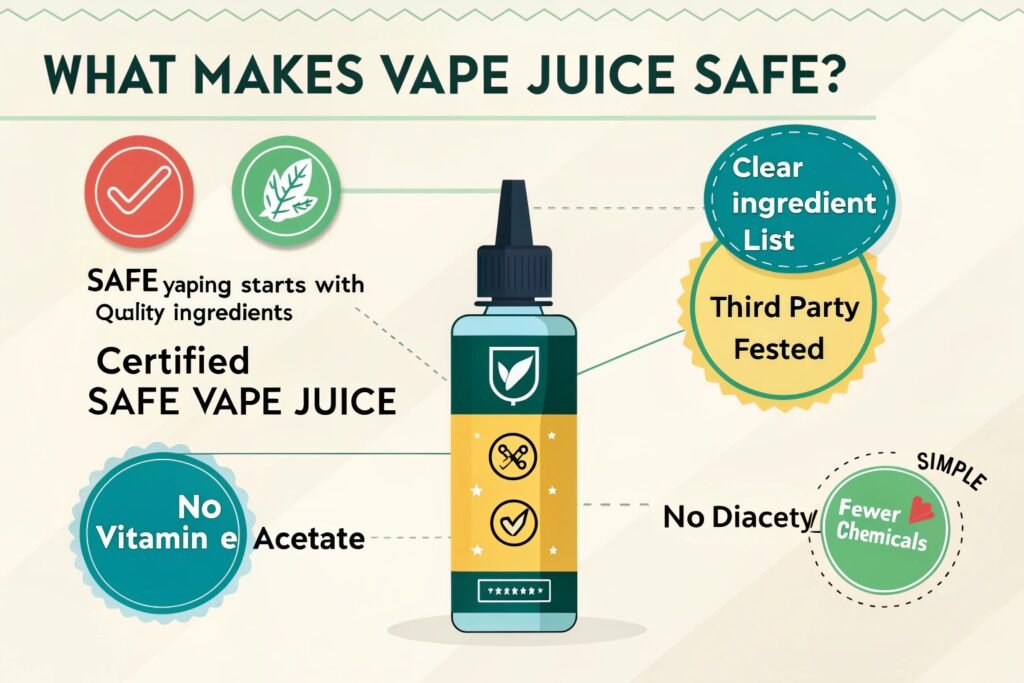 "A vape juice label highlighting 'Third-Party Tested' and 'No Added Chemicals'"
"A vape juice label highlighting 'Third-Party Tested' and 'No Added Chemicals'"
While vaping isn't risk-free, choosing high-quality, transparent e-liquids can minimize potential harm.
The factors that contribute to the safety of vape juice include the purity of ingredients, the absence of harmful additives4, and the compliance with safety standards. Drawing from my understanding of toxicology and product safety regulations, I've identified the following key determinants. The use of high-quality, pharmaceutical-grade ingredients5 minimizes the risk of contamination – the use of high-quality, pharmaceutical-grade ingredients minimizes the risk of contamination with harmful substances, such as heavy metals or pesticides. The absence of harmful additives, such as diacetyl, acetyl propionyl, and vitamin E acetate, reduces potential health risks – the absence of harmful additives, such as diacetyl, acetyl propionyl, and vitamin E acetate, reduces potential health risks associated with these chemicals, such as lung damage and respiratory problems. The compliance with safety standards and regulations ensures product quality and consistency – the compliance with safety standards and regulations, such as those set by the FDA or EU, ensures product quality and consistency, protecting consumers from potentially harmful products. The transparent labeling and ingredient disclosure allow consumers to make informed choices – transparent labeling and ingredient disclosure allow consumers to make informed choices about the products they use, enabling them to avoid ingredients they may be allergic to or concerned about. The third-party testing and certifications6 validate the safety claims and quality of the product – third-party testing and certifications validate the safety claims and quality of the product, providing consumers with assurance that the product has been independently tested and verified.
The harmful additives to avoid in vape juice include diacetyl, acetyl propionyl, vitamin E acetate, and heavy metals. Through analyzing toxicology reports and public health advisories, I've identified the following key substances to avoid. The diacetyl can cause bronchiolitis obliterans, a serious lung disease – diacetyl, a flavoring chemical used to create buttery flavors, can cause bronchiolitis obliterans, a serious lung disease characterized by inflammation and scarring of the small airways in the lungs. The acetyl propionyl is a similar chemical to diacetyl and may pose similar risks – acetyl propionyl is a similar chemical to diacetyl and may pose similar risks to the respiratory system, although more research is needed to fully understand its effects. The vitamin E acetate was linked to EVALI (e-cigarette or vaping product use-associated lung injury) – vitamin E acetate was linked to EVALI (e-cigarette or vaping product use-associated lung injury), a serious lung injury that emerged in 2019 and was associated with the use of contaminated vaping products. The heavy metals, such as lead and cadmium, can leach into e-liquids from vaping devices – heavy metals, such as lead and cadmium, can leach into e-liquids from vaping devices, posing a risk of heavy metal toxicity with long-term exposure. The formaldehyde can form during vaping if the e-liquid overheats – formaldehyde can form during vaping if the e-liquid overheats, posing a risk of respiratory irritation and potential long-term health effects.
The ways to minimize the risks associated with vaping include choosing reputable brands, using quality devices, and avoiding high-power settings. Through analyzing safety guidelines and expert recommendations, I've identified the following key strategies. The choosing reputable brands with transparent manufacturing practices – choosing reputable brands with transparent manufacturing practices ensures that the products are made with high-quality ingredients and adhere to safety standards. The using quality devices with safety features, such as temperature control and overcharge protection – using quality devices with safety features, such as temperature control and overcharge protection, enhances safety and prevents potential accidents. The avoiding high-power settings that can overheat the e-liquid and produce harmful byproducts – avoiding high-power settings that can overheat the e-liquid and produce harmful byproducts reduces the risk of exposure to toxic chemicals. The maintaining the device properly by cleaning it regularly and replacing coils as needed – maintaining the device properly by cleaning it regularly and replacing coils as needed ensures optimal performance and prevents the buildup of harmful residue. The staying informed about the latest research and safety recommendations – staying informed about the latest research and safety recommendations allows consumers to make informed choices and adopt safer vaping practices.
What is the healthiest liquid to vape?
Health is a priority, so what's the "healthiest" option?
**There is no such thing as a "healthy" vape liquid, as vaping inherently carries risks. However, if you choose to vape, the "least harmful" option would likely be an e-liquid with:
- No nicotine
- No added flavors
- Only VG as the base**
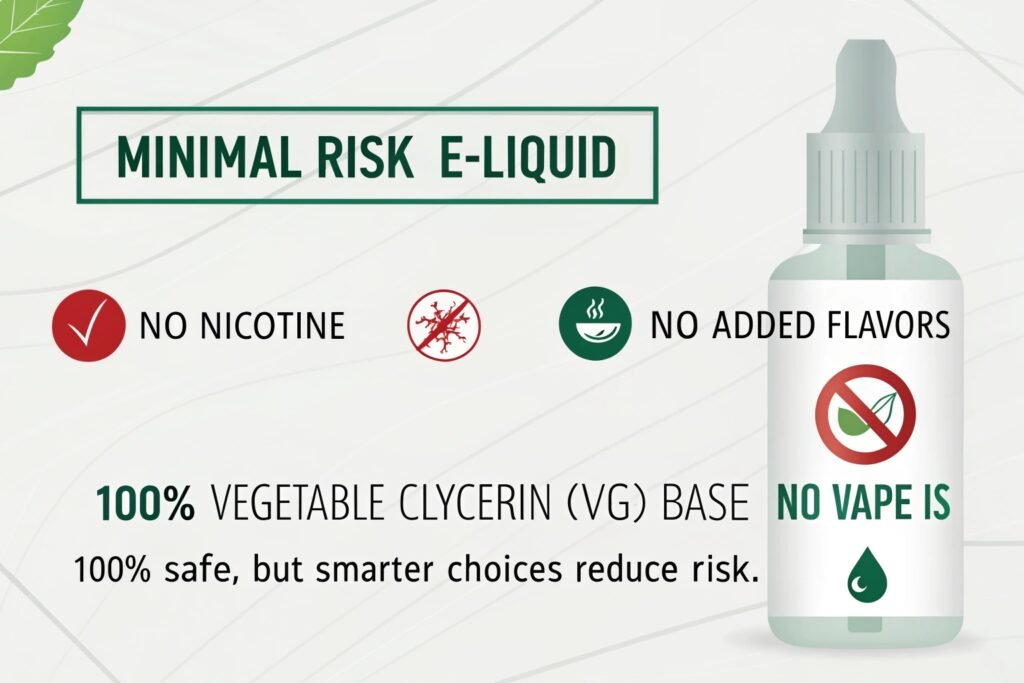 "A bottle of vegetable glycerin (VG) with no added nicotine or flavors"
"A bottle of vegetable glycerin (VG) with no added nicotine or flavors"
It's crucial to acknowledge that vaping is not a healthy activity. However, making informed choices can potentially reduce some of the risks.
The reasons why vaping is not considered a healthy activity include the potential for nicotine addiction7, the exposure to harmful chemicals8, and the unknown long-term effects. Drawing from my understanding of public health and toxicology, I've identified the following key concerns. The nicotine addiction can lead to dependence and withdrawal symptoms – nicotine is a highly addictive substance that can lead to dependence and withdrawal symptoms, such as cravings, irritability, and anxiety. The exposure to harmful chemicals, such as formaldehyde and acrolein, can damage the respiratory system – vaping exposes users to harmful chemicals, such as formaldehyde and acrolein, which can damage the respiratory system and increase the risk of lung disease. The unknown long-term effects of vaping9 on the cardiovascular system and brain are concerning – the long-term effects of vaping on the cardiovascular system and brain are still largely unknown, raising concerns about potential long-term health consequences. The vaping can exacerbate pre-existing respiratory conditions, such as asthma and COPD – vaping can exacerbate pre-existing respiratory conditions, such as asthma and COPD, leading to increased symptoms and reduced quality of life. The vaping is not a safe alternative to smoking and may lead to dual use – vaping is not a safe alternative to smoking and may lead to dual use, where individuals continue to smoke cigarettes while also vaping, increasing their overall exposure to harmful substances.
The potential benefits of using nicotine-free, unflavored VG-based e-liquids compared to traditional e-liquids include reduced nicotine addiction risk, fewer chemical additives, and milder respiratory effects. Through analyzing research studies and expert opinions, I've identified the following potential advantages. The reduced nicotine addiction risk eliminates the risk of dependence and withdrawal symptoms – using nicotine-free e-liquids eliminates the risk of nicotine addiction and withdrawal symptoms, making it easier to quit vaping if desired. The fewer chemical additives minimizes exposure to potentially harmful substances – using e-liquids with fewer chemical additives minimizes exposure to potentially harmful substances, reducing the risk of adverse health effects. The milder respiratory effects may be less irritating to the lungs – VG-based e-liquids with no added flavors may be less irritating to the lungs compared to traditional e-liquids with PG and flavorings, potentially reducing the risk of respiratory problems. The greater control over the vaping experience allows users to tailor the e-liquid to their individual needs – using nicotine-free, unflavored VG-based e-liquids gives users greater control over the vaping experience, allowing them to tailor the e-liquid to their individual needs and preferences. The potential for harm reduction compared to traditional smoking is still under investigation – the potential for harm reduction compared to traditional smoking is still under investigation, but some experts believe that vaping nicotine-free e-liquids may be less harmful than smoking cigarettes.
The recommendations for making informed decisions about vaping and minimizing potential harm include consulting with healthcare professionals, staying informed about the latest research, and considering quitting vaping altogether. Through analyzing public health guidelines and expert advice, I've identified the following key strategies. The consulting with healthcare professionals to discuss the risks and benefits of vaping – consulting with healthcare professionals allows individuals to discuss the risks and benefits of vaping and receive personalized recommendations based on their individual health status and medical history. The staying informed about the latest research and safety recommendations from reputable sources – staying informed about the latest research and safety recommendations from reputable sources, such as the CDC and NIH, enables consumers to make informed choices and adopt safer vaping practices. The considering quitting vaping altogether as the safest option for long-term health – considering quitting vaping altogether is the safest option for long-term health, as it eliminates the risks associated with nicotine addiction and exposure to harmful chemicals. The supporting policies and regulations aimed at reducing youth vaping and promoting public health – supporting policies and regulations aimed at reducing youth vaping and promoting public health helps protect vulnerable populations from the potential harms of vaping. The setting a good example for young people by not vaping or smoking – setting a good example for young people by not vaping or smoking helps prevent them from initiating these harmful behaviors.
Conclusion
Finding PG-free vape juice is possible with some research. While no vape juice is truly "healthy," you can make informed choices to minimize potential risks. Remember, the best option for your health is to avoid vaping altogether.
-
Explore this link to discover where to find high-quality PG-free vape juice that meets your preferences and health needs. ↩ ↩
-
Learn about the advantages of vegetable glycerin in vaping, including smoother hits and thicker vapor, to enhance your experience. ↩ ↩
-
Understanding the VG/PG ratio is crucial for optimizing your vaping experience; explore this link for detailed insights. ↩ ↩
-
Learn about the harmful additives to avoid in vape juice to protect your health and make informed choices. ↩
-
Explore this link to understand how high-quality ingredients can significantly reduce health risks in vaping. ↩
-
Discover the importance of third-party testing in ensuring the safety and quality of vape products for consumers. ↩
-
Understanding nicotine addiction is crucial for making informed choices about vaping and its health implications. ↩
-
Exploring the harmful chemicals in vaping products can help you understand the risks associated with vaping and make safer choices. ↩
-
Learning about the long-term effects of vaping is essential for assessing its safety and making informed decisions about its use. ↩


